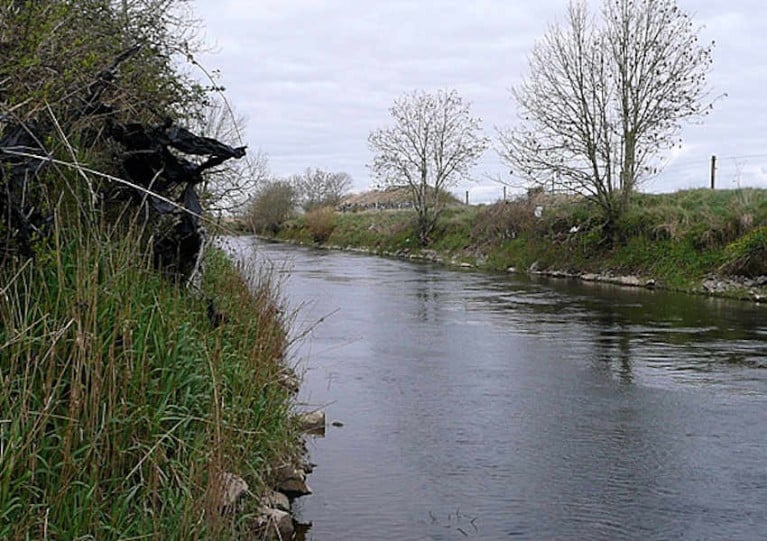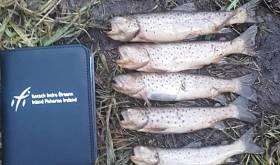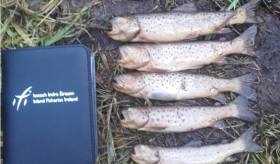Displaying items by tag: clare river
Wild Stocks in Key Western Salmon & Trout Fisheries To Get a Boost in New Projects
Improving stocks of wild salmon and trout in the West of Ireland in the goal of a new initiative launched by Inland Fisheries Ireland (IFI).
Derek Evans writes in The Irish Times about IFI’s partnership with Co Galway angling federation Cairde an Chláir to restore a near kilometre-long stretch of the Abbert River, a tributary of the River Clare.
Earlier this year the two groups signed a memorandum of understanding on the conservation and development of brown trout and salmon and their habitat, as previously reported on Afloat.ie.
While the coronavirus pandemic slowed progress over the year, IFI says the project is now at the stage where work on the river can begin — while a similar scheme to restore 8km of nursery streams such as the River Nanny is already under way.
The Irish Times has much more on the story HERE.
Minister Welcomes Formal Partnership Between IFI & Cairde Na Chláir For Conservation Efforts On Clare River
Sean Canney, Minister of State with responsibility for the inland fisheries sector, has welcomed the signing of a memorandum of understanding (MOU) between Inland Fisheries Ireland (IFI) and Cairde na Chláir, representing four of its member angling clubs on the Clare River.
The MOU will enable both parties to collaborate on the conservation and development of brown trout and salmon and their habitat on the Clare River.
Commenting on the significance of the partnership, Minister Canney said: “I fully support the signing of this MOU which represents the formalisation of a long standing collaborative relationship between Inland Fisheries Ireland and the Cairde na Chláir.
“This partnership is significant not just for the two organisations but for the Western River Basin District and the MOU will act as the motivation to develop the five year plan but also to further incentivise future collaborations and projects”.
IFI says this MOU is a declaration of a commitment from both parties to the development of a five-year plan that is focused on the conservation and development of brown trout and salmon and their habitat on the Clare River in the Western River Basin District.
It will enable a closer working relationship between both parties and recognises that conservation of the species and its habitat as the core guiding principle of this relationship, the inland fisheries body added.
The MOU was signed by Richard Jordan on behalf of the Cairde na Chláir and co-signed by the participating angling clubs and Suzanne Campion, IFI’s head of business development.
Due to current public health measures, parties will commence work on meeting the objectives of the MOU via virtual meetings.
IFI chief executive Dr Ciaran Byrne said: “During a time when we see the changes to our natural environment from the impact of climate change, this partnership agreement will work to ensure a plan is formed to maximise sustainable benefit for the species.”
He added: “Both parties hold the value of conservation and development of fisheries at the core of their organisation. We look forward to working with the clubs that comprise the Cairde na Chláir, learning from one another and developing joint initiatives at a time when collaborative work is critical for the future of our fisheries resource.”
Richard Jordan, on behalf of the Cairde na Chláir, said: “We welcome the signing of this MOU between clubs of Cairde na Chlair and Inland Fisheries Ireland to begin the process of creating a five year plan for the conservation and development of our brown trout and salmon.
“The Cairde na Chláir clubs involved in this MOU are the Milltown Anglers, Cregmore Athenry Anglers, St Colmans Anglers and the Tuam Anglers Association. The formalisation of this MOU marks an important consolidation of our working relationship with Inland Fisheries Ireland.”
Galway Landowner Convicted Over River Pollution Incident
#Angling - A landowner has been convicted of a breach to the Water Pollution Act in Glenamaddy, Co Galway that resulted in a major fish kill.
At a sitting of Tuam District Court, Michael Conneally of Boyounagh, Glenamaddy pleaded guilty to permitting silage effluent to enter the Yellow River, a tributary of the Clare River in Co Galway, on 15 June 2016.
David Harrington, senior fisheries environmental officer with Inland Fisheries Ireland (IFI), gave evidence of tracing the source of the fish kill back to a pipe originating from a silage pit on Conneally’s land.
The pollution incident resulted in damage to fish stock in the Yellow River, which is an important spawning tributary for salmon and trout with the absence of aquatic life noted for a considerable distance downstream, as previously reported on Afloat.ie.
Conneally fully co-operated with officers from IFI and sought to remedy the incident without delay. However, the polluting matter had already impacted the river.
Judge Mary Devins convicted Conneally and fined him €750 with three months to pay, as well as laboratory expenses of €464.94 and legal costs of €600.
IFI chief executive Dr Ciaran Byrne said: “We would appeal to farmers for continued vigilance to help protect our waterways from agricultural pollution.
“At this time of year, silage is in full swing and silage effluent can be a highly toxic substance when it gets into rivers, starving the fish and invertebrate life of oxygen. This incident on the Clare River highlights the large impact one leak can have on our fisheries resource.”
The Clare River is the largest tributary of Lough Corrib, and sees thousands of salmon and trout run the river to spawn every year. It provides a valuable angling facility for local and tourist anglers in the West of Ireland.
There are six different angling clubs along the river who have made significant investment in recent years to help improve the spawning and nursery habitat for salmon and trout. The clubs rely on the responsible environmental stewardship of local farmers to maintain the Clare River as a key angling resource.
Angling in Ireland currently contributes €836 million to the Irish economy annually, supporting upwards of 11,000 jobs.
Major Fish Kill on Spawning Tributary of Clare River, Galway
Inland Fisheries Ireland is currently investigating a major fish kill on the Yellow River, a tributary of the Sinking River near Dunmore, Co. Galway, which flows into the Clare River. The stream in question is an important spawning and nursery habitat for young trout and salmon.
Staff were notified of the fish kill late last week and an immediate inspection revealed large numbers of dead fish in the river over almost one kilometre downstream. Dead crayfish were also found. Staff traced the source of the pollution to silage effluent leaking from a silage pit on a nearby farm. Samples and photographs were taken, and a prosecution will be taken in light of the severe nature of the pollution.
Inland Fisheries Ireland is again appealing to farmers to exercise vigilance when harvesting and making silage at this time of year. Water levels are low in many rivers, so any pollution has a much greater impact. It is vital to prevent any leakage from silage pits, and to ensure slurry is only spread in suitable conditions and well away from streams and drains.
Commenting on the incident, Dr Ciaran Byrne, CEO of Inland Fisheries Ireland said “Protection of fish stocks is vital to maintaining an extremely valuable natural resource for the benefit of local and tourist anglers alike.
“Recreational angling in Ireland is worth over €836 million to the economy and supports over 11,000 jobs. Salmon and trout, in particular, depend on good water quality to survive, and IFI is committed to protecting water quality in our rivers and lakes. Members of the public can assist fisheries staff by reporting all instances of illegal fishing or pollution to IFI’s confidential 24 Hour hotline number at 1890 347 424".
































































